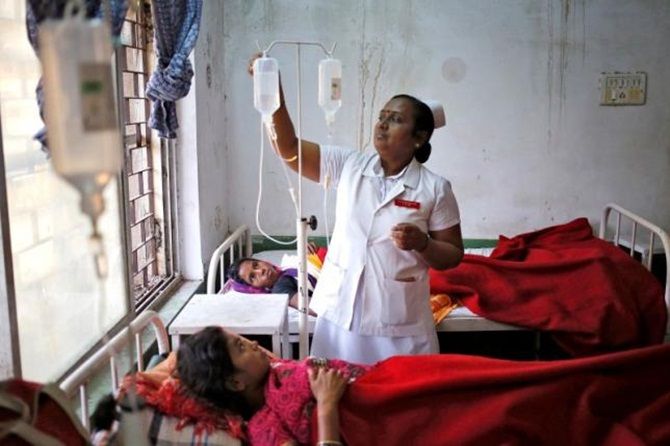 | « Back to article | Print this article |
Going by current trend, around half of private hospitals and most of government hospitals in the country will have to close down in the next five years because of an acute shortage of nurses, points out Subir Roy.
 To all the ills afflicting healthcare in India, here is one more.
To all the ills afflicting healthcare in India, here is one more.
The acute shortage of nurses in the country (across states supply of nurses is a good proxy for overall health outcomes) is likely to get worse with the UK determining that it has a shortage of nurses.
Many nurses from non-European countries, significantly India, who were fearing having to leave will not have to do so. Plus, visa applications from nurses will be processed faster.
While the impact of this on overall supply will be at the margin, what is much more serious is the underlying deep-rooted problem. India has a phenomenal 2.4 million shortage of nurses.
The shortage in developing countries generally is linked to inadequate training facilities, but in India seats in nursing colleges are increasingly falling vacant and the annual supply of nurses is dwindling.
Furthermore, those who are qualifying are eagerly looking for better paid jobs in richer countries.
Devi Shetty, health entrepreneur and founder of Narayana Health, has painted an alarming picture recently in The Economic Times.
In 2009 India had 1.65 million nurses, now it has 1.56 million. Admission to nursing colleges has come down by half and around half of the nursing colleges in the south, key suppliers, are closing down.
Going by current trend, around half of private hospitals and most of government hospitals in the country will have to close down in the next five years because of an acute shortage of nurses.
Why is the supply of nurses falling? Career prospects for them are bleak so the profession is becoming increasingly unattractive, says Dr Shetty.
Contrary to what is allowed in other countries, in India even a nurse with 20 years' ICU experience cannot administer a simple painkiller or give an injection unless a doctor is around.
In the US, anesthesia is administered in 67 per cent of the cases by nurses, but in India they cannot do so. India has reduced its nurses to a pair of hands only capable of giving "sponge baths".
Dr Shetty's solution? The health ministry and the Indian Nursing Council should create speciality courses to train nurse practitioners, nurse intensivists and nurse anesthetists.
This will enable them to earn higher salaries for which they go to West Asia. The solution does not lie in FDI.
A 300-bed speciality hospital can be constructed in six months; it takes eight years to train a nurse to manage a child on a ventilator.
From this it would follow that the key culprit is wrong attitudes and lack of foresight among policy makers.
The buck ultimately stops with them but more is needed to complete the picture.
Since the root cause for poor supply is poor pay, private hospitals (the future of their business is at stake) can immediately raise nurses' pay even for doing the same work.
This will cover a large chunk of healthcare delivery in India where 68 per cent of expenditure is private.
There is also considerable fiscal space (public expenditure on healthcare is only 1.3 per cent of GDP) for the government to pay nurses more.
But where will private hospitals find the money? Surely not by getting patients to pay more. It is the doctors, the specialists, who can be asked to earn a little less, which will be a much smaller proportion of their income than the percentage by which nurses' pay will go up.
However, this will not be a long term solution. That will have to follow the path outlined by Dr Shetty. But here also doctors have a role to play.
They, through their lobby, the Indian Medical Association (IMA), have over decades zealously guarded the space available to them.
When Dr Shetty outlined similar solutions in an article in Forbes India earlier in the year, it prompted a doctor to comment that the article had called "a spade a spade" but also add, "our IMA may not be able to swallow the suggestion of nurse practitioners, physicians and anesthetists."
The IMA also last year came out strongly against nurses (among other non-MBBS people) being allowed to perform abortions (medical termination of pregnancies).
An abortion, performed early, need not be more complicated than a difficult child birth and the reality is that only 67 per cent of births in India are attended by skilled personnel.
It is also a historical fact that India has not had the kind of "barefoot doctors" that China devised at one stage in its development because India's doctors and their lobby vehemently opposed the introduction of truncated courses to churn out rural practitioners.
Finally, there is a cultural bias against nursing as a profession among Hindus.
Hence Christians are over-represented among nurses with Kerala and Goa accounting for 40 per cent of India's nursing schools.
So to overcome the nursing shortage, attitudes have to change across the board - among policy makers, doctors, hospitals (private and public) and the public at large.